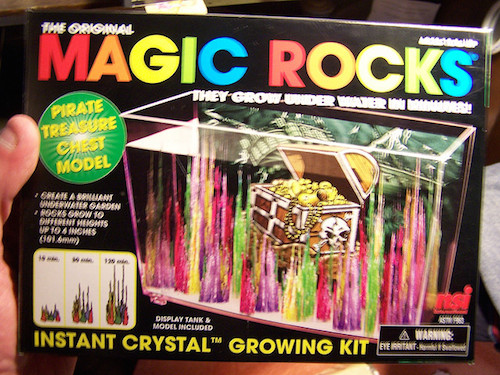 Evolution
Evolution
 Intelligent Design
Intelligent Design
 Life Sciences
Life Sciences
Is That Life Forming Before My Eyes? Will I Be in the National Academy of Sciences Someday?

In the age of Xbox, we’re not sure how in demand they are as a Christmas gift anymore, but look here, Amazon still sells them. They are "Magic Rocks" kits and if you’re of a certain age you may remember how, as a kid, you added "Magic Solution" to pebbles in a container of water and watched colorful crystal pillars grow right before your eyes. You could almost imagine a miniature civilization flourishing among the castles and towers that emerged, like magic, from the liquid.
Some of your peers, like Peter Pan, have not quite grown up. Now they are scientists. Their imaginations, though, are still wild and free, waiting for life to appear among the castle towers. "Magic rocks" (basically metal salts in a solution of sodium silicate) sounds a little too weird for the National Academy of Sciences, so they call them "chemical gardens" now. In the Proceedings of the National Academy of Sciences, Florence Haudin and colleagues in Belgium and Spain looked hopefully into the growing crystals for possible solutions to the origin of life. They found "spirals, flowers, and filaments" emerging before their eyes.
To be sure, their paper, "Spiral precipitation patterns in confined chemical gardens," does not specifically focus on the origin of life. The flowers that bloomed in their lab were only shapes of flowers. Yet they see great potential for learning about self-organizational patterns:
Chemical gardens, discovered more than three centuries ago, are attracting nowadays increasing interest in disciplines as varied as chemistry, physics, nonlinear dynamics, and materials science. Indeed, they exhibit rich chemical, magnetic, and electrical properties due to the steep pH and electrochemical gradients established across their walls during their growth process (2). Moreover, they share common properties with structures ranging from nanoscale tubes in cement (3), corrosion filaments (4) to larger-scale brinicles (5), or chimneys at hydrothermal vents (6). This explains their success as prototypes to grow complex compartmentalized or layered self-organized materials, as chemical motors, as fuel cells, in microfluidics, as catalysts, and to study the origin of life (7-18). (Emphasis added.)
After that brief suggestion about the origin of life, they delve into some of the interesting shapes you can get when growing the chemical gardens in spaces where the effects of buoyancy may be minimized. This is all fine as a chemistry experiment. But they cite a dozen references after that phrase about the "origin of life," suggesting that the subject was on their minds. The first reference is to a 1997 paper by Michael Russell, a JPL researcher famous for proposing that life began at the hydrothermal vents that resemble the castle towers in chemical gardens.
The hint was not lost on Oliver Steinbock at Florida State, who wrote a Commentary article in the same issue of PNAS:
As outlined in this commentary, the lessons to be learned from the growth dynamics of chemical gardens will provide an interesting model for the study of materials synthesis under nonequilibrium conditions.
However, the relevance of this system extends much further, as life on Earth might have started in very similar materials. As proposed by Russell et al. and others, hydrothermal vents — or more precisely the cooler, off-axis alkaline vents — constituted an ideal hatchery for prebiotic chemistry and early forms of life-like systems (12).
That reference #12 is to a 2014 paper by Russell in the journal Astrobiology, "The drive to life on wet and icy worlds." Russell envisions chemical gardens at deep-sea vents as places where prebiotic chemicals can become concentrated, flowing in ways that resemble metabolic pathways. Steinbock elaborates:
These chimney-like structures formed when mineral-rich water (containing also other species such as CO, H2, and CH4) surged into the anaerobic Hadean ocean. Their precipitation walls offered a phelotra of micro- and macropores that created celllike spatial confinement without the presence of lipids. Moreover, the structures consisted of various minerals, including sulfides and oxides of metal ions, such as iron and nickel. These geochemical catalysts might have jump-started the production of compounds that subsequently modified the reactivity of the pore surfaces in a biocatalytically relevant fashion. Finally, the wall structures were exposed to steep and extremely long-lived concentration gradients that are reminiscent of modern transmembrane gradients in living cells. The work by Haudin et al. (1) has the potential to assist in the experimental analysis of these questions by providing simple, microfluidic geometries for the more direct characterization of inorganic membrane systems that seem relevant to this intriguing origins-of-life hypothesis.
What’s wrong with this imaginative picture? There’s no biological or genetic information! It’s all bubbles and rocks that merely resemble cellular compartments, without the lipid membranes. It’s chemical reactions that (with another assist from your imagination) resemble metabolism, but without the complex protein catalysts. It’s concentration gradients that resemble active transport in cell membranes, but without the complex channels with their protein-guided selectivity filters that permit functional molecules and prevent others. How are the real biological structures assembled? They require information, and with it, the whole shebang of transcription, translation, and assembly machinery that guides each part to its proper place.
Without the genetic instructions, it doesn’t matter how much the filaments and flowers resemble life. They’re as dead as carvings of flowers compared to real roses. The relevant question is, What is the origin of genetic information? Without that, looking at hydrothermal vents on a sterile planet in the expectation that life will form is no better than watching magic rocks and imagining kings, queens, and subjects spontaneously appearing, carrying on imaginary adventures, and living happily ever after.
